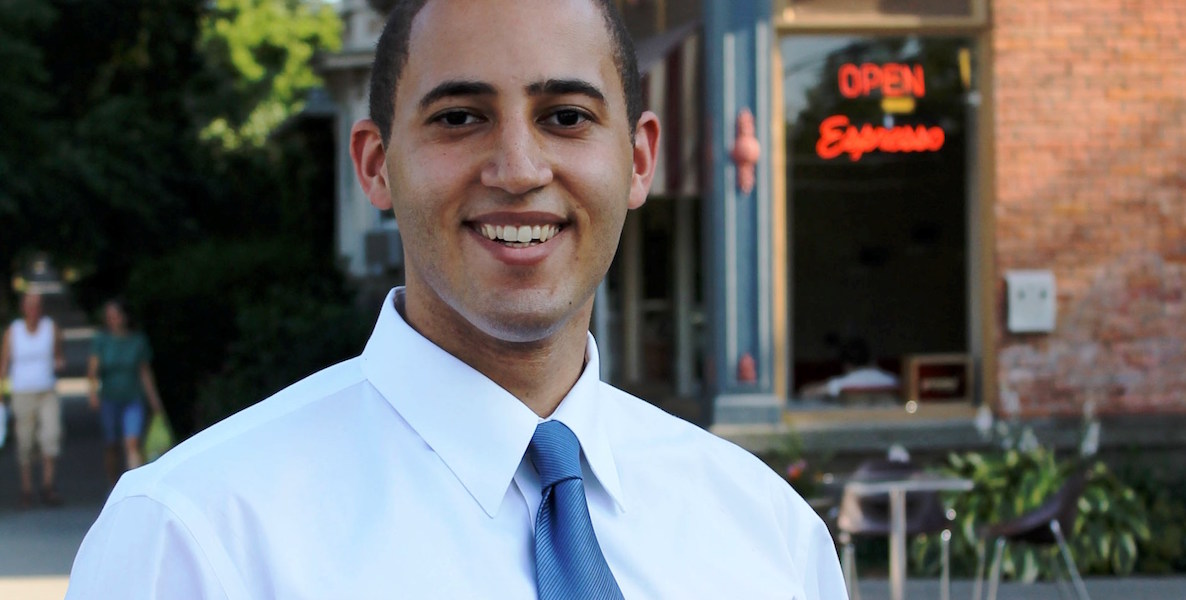Earlier in 2016, Svante Myrick, the then-29-year-old mayor of Ithaca, New York, proposed a radical plan to deal with the town’s growing heroin epidemic that even surprised him a little: The city of 30,000 would be the first in the U.S. to provide a safe space for addicts to shoot up legally and under professional supervision.
Almost immediately, critics pounced on Myrick’s call for “supervised injection facilities” as little more than, as one Cornell law professor put it, a “government-run heroin shooting gallery” that would enable more drug abuse, rather than deter it. But Myrick, whose absent father was a crack cocaine addict, knew something had to be done. Last year, in a 10-day period around the time Myrick convened a committee to address the epidemic, there were more than a dozen overdoses, three of them fatal. In total last year, 14 people died from fatal overdoses in the county where Ithaca is the only city. Nationwide, heroin abuse and prescription opioids kill 78 people a day, according to the Centers for Disease Control and Prevention.
Still, even Myrick needed proof that the idea could work before agreeing to the radical approach proposed by his committee. He found it in Vancouver, where a similar program over two years led to a 35 percent drop in fatal overdoses in the surrounding area, and where addicts are 30 percent more likely to seek treatment if they use the facility. The so-called shooting gallery is only one element of a four-part plan Myrick launched that also includes prevention, treatment and law enforcement, including more drug education, a detoxification center, general health care for addicts and a methadone clinic.
That Myrick was able to propose such an audacious plan speaks to the force of his popularity in Ithaca: He won reelection last year with 89 percent of the vote, just four years after becoming the city’s youngest mayor, at 24, and its first mayor of color. And it speaks to a lifetime of being taught to put his entire heart in and go big.
Myrick and his siblings were raised by a single mother who worked multiple low-paying jobs that kept them in and out of homelessness. He says the family of five never made it out of poverty when he was growing up in the tiny town of Earlville, New York, relying on a combination of government assistance, help from his grandparents, kindness of strangers and, when the kids were old enough to work, part-time jobs. “(My mother) went above and beyond. She sacrificed everything … She saved our lives,” Myrick said in an interview shortly after he took office.
He arrived in Ithaca as a teenager to attend elite Cornell University on a financial aid package of scholarships, Pell grants, work study and loans, on top of part-time jobs. But he still found time to volunteer and work with area youth.
Even before Myrick could finish college, his work in the community led to his being approached to run for city council. A 19 year-old communications major in his junior year, Myrick wondered if he would be able to make a four year commitment to the Common Council while keeping his grades up as his scholarships required, and doing his work study, his tutoring and his part-time bartending gig. Still, in January 2008, at the age of 20, Myrick became the youngest alderperson in Ithaca and among the youngest elected African Americans in U.S. history. As an alderman, he helped develop the Ithaca Youth Council and helped create tobacco-free zones in the town’s green areas.
Three years later, and with an Ivy League degree under his belt, Myrick ran for mayor, winning with more than half the votes—and a nearly 30 percent margin over the next closest candidate. When he was sworn in on New Year’s Day in 2012, Myrick took over a city with a unique population: Ithaca is home to the highest percentage of residents with undergraduate degrees; and nearly half of the city’s residents are living in poverty.
Shortly after becoming mayor, Myrick gained notoriety for joining approximately 15 percent of Ithacans who walk to work by giving up his car and turning his prime downtown parking spot into a tiny park. Or, as he put it, he decided to “turn the Mayor’s parking space into a park space” complete with flowers, tree trunk planters and park benches.
In Vancouver, a similar program over two years led to a 35 percent drop in fatal overdoses in the surrounding area, and addicts are 30 percent more likely to seek treatment if they use the facility.
Simultaneously, Myrick did two things. He showed he was thinking about the importance of public green spaces and he addressed what many considered to be an overly trafficked city, one of his campaign issues. “The answer to too many cars is not necessarily more parking spaces,” Myrick wrote on his campaign site. “We can change traffic patterns and parking behaviors by providing alternative methods of transportation which are more affordable, reliable and convenient.”
Myrick says the central achievement of his first term was being able to close the gap on a $3 million deficit he inherited from his predecessor. He’s also generated new revenue by selling long-sitting, unused city-owned land that resulted in $300,000 in sales and new tax revenues. And he’s slowly eased the demand and cost of housing by rezoning certain neighborhoods for new construction.
But Myrick has struggled to reduce his city’s poverty. In fact, it’s gone in quite the opposite direction. According to his State of the City address last year, income wealth is being shifted to upper income households at a faster rate in Ithaca than almost anywhere else in the country. From his personal experience, Myrick knows pulling somebody out of poverty isn’t something a mayor can handle on his own.
“This is not the story of a self-made man,” he said in a 2012 interview. “This is the story of a community that conspired to raise a child. That’s the truth.”
Photo header: Wikimedia Commons/HoJfellas




